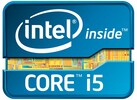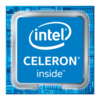Intel Core i5-3360M vs Intel Celeron N5095A vs Intel Core i5-3427U
Intel Core i5-3360M
► remove from comparison
Der Intel Core i5-3360M ist ein schneller mobiler Dual-Core Prozessor und basiert auf der Ivy Bridge Architektur. Dank Hyperthreading können die 2 Kerne gleichzeitig bis zu 4 Threads bearbeiten. Die Fertigung erfolgt im Gegensatz zum Vorgänger Sandy Bridge, der noch in 32 Nanometer produziert wurde, in einem kleineren 22 Nanometer Prozess mit 3D-Transistoren. Mit einer Taktrate von 2,8 GHz (maximaler Turbo: 3,3 GHz für 2 Kerne, 3,5 GHz für 1 Kern) befindet sich der i5-3360M zwischen dem i5-3320M (2,6 GHz) und dem i7-3520M (2,9 GHz), der zudem den größeren L3-Cache (4 MB statt 3 MB) besitzt.
Ivy Bridge ist ein Die Shrink der Sandy Bridge Architektur, der nur an wenigen Stellen verbessert wurde. Unter anderem werden nun PCI Express in der neuen Version 3.0 sowie DDR3(L)-1600 unterstützt. Keine Änderungen gab es beim Featureset, welches weiterhin beispielsweise die Verschlüsselungstechnik AES-NI, die Befehlssatzerweiterung AVX sowie Turbo-Boost 2.0 umfasst.
Die Performance des i5-3360M liegt durch kleinere Verbesserungen der Pro-MHz-Leistung etwa 5 % über einem taktgleichen Modell der Sandy Bridge Architektur. Verglichen mit dem i7-3520M fällt der Prozessor etwa 5 % zurück, kann jedoch den i7-2640M der Vorgängergeneration schlagen. Während die Singlethreadleistung zum Teil ältere Quadcore-Modelle übertrifft, ist bei Auslastung aller Kerne bereits ein i7-2630QM erheblich schneller. Dennoch genügt die Leistungsfähigkeit, um auch anspruchsvolle Anwendungen wie HD-Videoschnitt oder aktuelle 3D-Spiele zu meistern.
Für die Grafikausgabe zeigt sich die im Prozessor integrierte Intel HD Graphics 4000 mit 16 sogenannten Execution Units (EUs) verantwortlich. Mittels Turbo-Modus kann die Ausgangstaktrate von 650 MHz bis auf 1200 MHz ansteigen. Die Leistung liegt um etwa 40 % über der des Vorgängers (HD Graphics 3000), womit auch die Grafiklösung von Llano (Radeon HD 6620G als schnellstes Modell) erreicht wird.
Wie die meisten Dualcore-Modelle der Sandy Bridge Reihe besitzt auch der i5-3360M eine TDP von 35 Watt, die auch die Grafikeinheit beinhaltet. Damit ist die CPU am besten für Notebooks ab 14 Zoll geeignet.
Intel Celeron N5095A
► remove from comparison
The Celeron N5095A is an inexpensive quad-core SoC of the Jasper Lake product family designed for use in affordable SFF desktops and laptops. It features four Tremont CPU cores running at 2 GHz that Boost to up to 2.9 GHz with no thread-doubling Hyper-Threading technology in sight. A pretty basic iGPU is present as well.
The only difference between the N5095A and the N5095 is that the former comes with support for more proprietary Intel technologies such as the Smart Sound DSP, Wake on Voice and HD Audio.
Architecture and Features
Tremont brings many improvements over Goldmont Plus, the architecture that we know from the N5030 and myriads of other N-class CPUs. An up to 30% boost in single-thread performance is to be expected thanks to smarter prefetchers, branch prediction improvements and other refinements, according to Intel. These new chips are physically larger than their immediate predecessors as a result. Either way, this is still a "small" core rather than a "big" one according to ChipsAndCheese.
The Celeron has 1.5 MB of L2 and 4 MB of L3 cache and is compatible with DDR4-2933 and LPDDR4x-2933 memory or slower. Support for Intel CNVi Wi-Fi 6 modules is baked into the chip, as are 8 PCIe 3.0 lanes for NVMe SSD speeds up to 3.9 GB/s. USB 4 or Thunderbolt aren't supported however.
Please also note that the Celeron gets soldered to the motherboard (BGA1338 socket interface) for good and is thus not user-replaceable.
Performance
While we haven't tested a single system featuring the N5095A as of Sep 2024, we have done several reviews of computers/laptops powered by the N5095. CPU performance should be pretty much identical between the two. Therefore, we fully expect the chip to be about as fast as the Core i3-10110U, Core i3-1005G1, Celeron N5105 and also the Ryzen 3 3200U in multi-threaded workloads. Which is just enough for the most basic of tasks in late 2024.
Performance will get a significant hit if the power target is set to 10 W or 6 W instead of the Intel-recommended 15 W value.
Graphics
The DirectX 12.1-capable 16 EU UHD Graphics runs at up to 750 MHz and is in many respects similar to what Ice Lake CPUs come equipped with. This graphics adapter is capable of driving up to 3 SUHD displays simultaneously; HEVC, AVC, VP9, MPEG-2 and other popular video codecs can all be hardware-decoded. AV1 and VVC can't.
As far as gaming is concerned, it is reasonable to expect playable framerates in really old games (like Dota 2 Reborn) provided one sticks to lower resolutions such as HD 720p.
Power consumption
While most N-class chips have a 6 W long-term power target, the Celeron N5095A has a 15 W TDP to mimic much faster U-class Core processors. This isn't a great CPU for passively cooled designs.
The N5095A is built with the same 10 nm Intel process as Ice Lake-U processors for pretty unimpressive power efficiency, as of late 2024.
Intel Core i5-3427U
► remove from comparisonDer Intel Core i5-3427U ist ein stromsparender ULV-Prozessor basierend auf der Ivy Bridge Architektur. Die mit einem "U" am Ende der Modellbezeichnung gekennzeichnete CPU ist insbesondere für den Einsatz in Ultrabooks vorgesehen. Dank Hyperthreading können die 2 Kerne gleichzeitig bis zu 4 Threads bearbeiten. Die Fertigung erfolgt im Gegensatz zum Vorgänger Sandy Bridge, der noch in 32 Nanometer produziert wurde, in einem kleineren 22 Nanometer Prozess mit 3D-Transistoren. Mit einer Taktrate von 1,8 GHz (maximaler Turbo: 2,6 GHz für 2 Kerne, 2,8 GHz für 1 Kern) befindet sich der i5-3427U knapp unter dem i7-3667U (2,0 GHz), der zudem den größeren L3-Cache (4 MB statt 3 MB) besitzt.
Ivy Bridge ist ein Die Shrink der Sandy Bridge Architektur, der nur an wenigen Stellen verbessert wurde. Unter anderem werden nun PCI Express in der neuen Version 3.0 sowie DDR3(L)-1600 unterstützt. Keine Änderungen gab es beim Featureset, welches weiterhin beispielsweise die Verschlüsselungstechnik AES-NI, die Befehlssatzerweiterung AVX sowie Turbo-Boost 2.0 umfasst.
Die Performance des i5-3427U liegt durch kleinere Verbesserungen der Pro-MHz-Leistung etwa 5 % über einem taktgleichen Modell der Sandy Bridge Architektur. Verglichen mit dem i7-3667U fällt der Prozessor etwa 10 % zurück und erreicht den i7-2677M der Vorgängergeneration sowie den i3-2330M mit einer deutlich höheren TDP von 35 Watt. Die Leistungsfähigkeit reicht aus, um auch anspruchsvolle Anwendungen wie HD-Videoschnitt oder aktuelle 3D-Spiele befriedigend zu meistern.
Für die Grafikausgabe zeigt sich die im Prozessor integrierte Intel HD Graphics 4000 mit 16 sogenannten Execution Units (EUs) verantwortlich. Mittels Turbo-Modus kann die Ausgangstaktrate von niedrigen 350 MHz bis auf 1150 MHz ansteigen. Die Leistung liegt um etwa 60 % über der des Vorgängers (HD Graphics 3000), womit auch die Grafiklösung von Llano (Radeon HD 6620G als schnellstes Modell) erreicht wird.
Wie die ULV-Modelle der Sandy Bridge Reihe besitzt auch der i5-3427U eine TDP von 17 Watt, die auch die Grafikeinheit beinhaltet. Damit ist die CPU am besten für Ultrabooks oder andere besonders kleine und leichte Notebooks geeignet.
| Model | Intel Core i5-3360M | Intel Celeron N5095A | Intel Core i5-3427U | ||||||||||||||||||||||||||||||||||||||||||||||||||||||||||||||||||||||||||||||||||||||||||||||||||||||||||||||||||||||||||||||||
| Codename | Ivy Bridge | Jasper Lake | Ivy Bridge | ||||||||||||||||||||||||||||||||||||||||||||||||||||||||||||||||||||||||||||||||||||||||||||||||||||||||||||||||||||||||||||||||
| Series | Intel Core i5 | Intel Jasper Lake | Intel Core i5 | ||||||||||||||||||||||||||||||||||||||||||||||||||||||||||||||||||||||||||||||||||||||||||||||||||||||||||||||||||||||||||||||||
| Serie: Core i5 Ivy Bridge |
|
|
| ||||||||||||||||||||||||||||||||||||||||||||||||||||||||||||||||||||||||||||||||||||||||||||||||||||||||||||||||||||||||||||||||
| Clock | 2800 - 3500 MHz | 2000 - 2900 MHz | 1800 - 2800 MHz | ||||||||||||||||||||||||||||||||||||||||||||||||||||||||||||||||||||||||||||||||||||||||||||||||||||||||||||||||||||||||||||||||
| L1 Cache | 128 KB | 128 KB | |||||||||||||||||||||||||||||||||||||||||||||||||||||||||||||||||||||||||||||||||||||||||||||||||||||||||||||||||||||||||||||||||
| L2 Cache | 512 KB | 1.5 MB | 512 KB | ||||||||||||||||||||||||||||||||||||||||||||||||||||||||||||||||||||||||||||||||||||||||||||||||||||||||||||||||||||||||||||||||
| L3 Cache | 3 MB | 4 MB | 3 MB | ||||||||||||||||||||||||||||||||||||||||||||||||||||||||||||||||||||||||||||||||||||||||||||||||||||||||||||||||||||||||||||||||
| Cores / Threads | 2 / 4 | 4 / 4 4 x 2.9 GHz Intel Tremont | 2 / 4 | ||||||||||||||||||||||||||||||||||||||||||||||||||||||||||||||||||||||||||||||||||||||||||||||||||||||||||||||||||||||||||||||||
| TDP | 35 Watt | 15 Watt | 17 Watt | ||||||||||||||||||||||||||||||||||||||||||||||||||||||||||||||||||||||||||||||||||||||||||||||||||||||||||||||||||||||||||||||||
| Technology | 22 nm | 10 nm | 22 nm | ||||||||||||||||||||||||||||||||||||||||||||||||||||||||||||||||||||||||||||||||||||||||||||||||||||||||||||||||||||||||||||||||
| Features | HD Graphics 4000 (650-1200MHz), DDR3-1600 Memory Controller, HyperThreading, AVX, Quick Sync, Virtualization | DDR4-2933/LPDDR4x-2933 RAM, PCIe 3, GNA, MMX, SSE, SSE2, SSE3, SSSE3, SSE4.1, SSE4.2, VMX, SMEP, SMAP, EIST, TM1, TM2, Turbo, SST, AES-NI, RDRAND, RDSEED, SHA | Turbo Boost 2.0, Hyper-Threading, Virtualization VT-x, AES, Intel 64, Anti-Theft, My WiFi, Idle States, Enhanced SpeedStep, Thermal Monitorin, Execute Disable Bit | ||||||||||||||||||||||||||||||||||||||||||||||||||||||||||||||||||||||||||||||||||||||||||||||||||||||||||||||||||||||||||||||||
| iGPU | Intel HD Graphics 4000 (650 - 1200 MHz) | Intel UHD Graphics (Jasper Lake 16 EU) (450 - 750 MHz) | Intel HD Graphics 4000 (350 - 1150 MHz) | ||||||||||||||||||||||||||||||||||||||||||||||||||||||||||||||||||||||||||||||||||||||||||||||||||||||||||||||||||||||||||||||||
| Architecture | x86 | x86 | x86 | ||||||||||||||||||||||||||||||||||||||||||||||||||||||||||||||||||||||||||||||||||||||||||||||||||||||||||||||||||||||||||||||||
| $266 U.S. | $225 U.S. | ||||||||||||||||||||||||||||||||||||||||||||||||||||||||||||||||||||||||||||||||||||||||||||||||||||||||||||||||||||||||||||||||||
| Announced | |||||||||||||||||||||||||||||||||||||||||||||||||||||||||||||||||||||||||||||||||||||||||||||||||||||||||||||||||||||||||||||||||||
| Manufacturer | ark.intel.com | ark.intel.com | ark.intel.com | ||||||||||||||||||||||||||||||||||||||||||||||||||||||||||||||||||||||||||||||||||||||||||||||||||||||||||||||||||||||||||||||||
| Socket | BGA1338 | BGA1023 | |||||||||||||||||||||||||||||||||||||||||||||||||||||||||||||||||||||||||||||||||||||||||||||||||||||||||||||||||||||||||||||||||
| max. Temp. | 105 °C |
Benchmarks
Average Benchmarks Intel Core i5-3360M → 0% n=0
Average Benchmarks Intel Core i5-3427U → 0% n=0
* Smaller numbers mean a higher performance
1 This benchmark is not used for the average calculation










